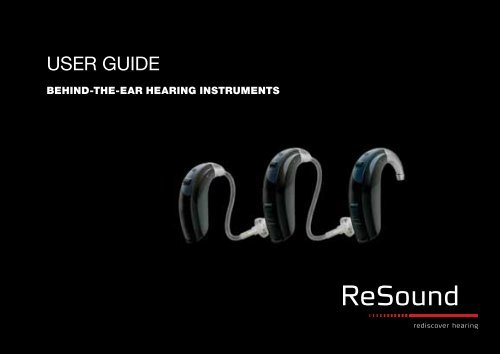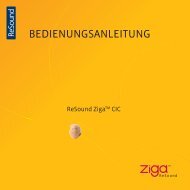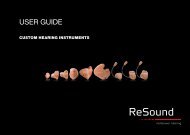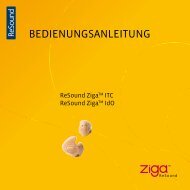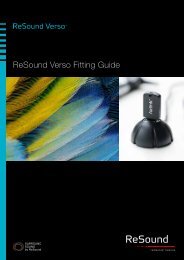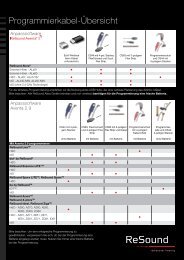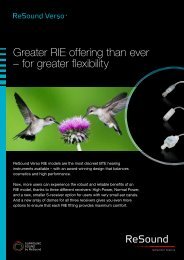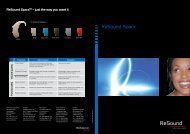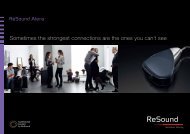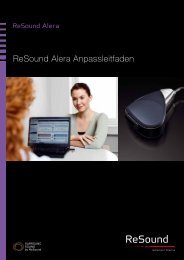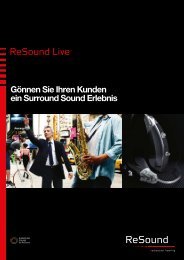USER GUIDE - GN ReSound
USER GUIDE - GN ReSound
USER GUIDE - GN ReSound
Create successful ePaper yourself
Turn your PDF publications into a flip-book with our unique Google optimized e-Paper software.
<strong>USER</strong> <strong>GUIDE</strong>Behind-The-Ear Hearing Instruments
Hearing instrument type designations for models included in this user guide are: M60, FCC ID: X26M60, IC:6941C-M60; M70-80, FCC ID: X26M70-80, IC: 6941C-M7080; and M70-80e, FCC ID: X26M70-80e, IC:6941C-M7080e. Please see page 8 for a list of models referring to these types.Statement:This device complies with Part 15 of the FCC Rules.Operation is subject to the following two conditions: (1) this device may not cause harmful inter ference,and (2) this device must accept any interference received, including interference that may cause undesiredoperation.Note: This equipment has been tested and found to comply with the limits for a Class B digital device, pursuantto part 15 of the FCC Rules. These limits are designed to provide reasonable protection against harmfulinterference in a residential installation. This equipment generates, uses and can radiate radio frequencyenergy and, if not installed and used in accordance with the instructions, may cause harmful interferenceto radio communications. However, there is no guarantee that interference will not occur in a particularinstallation. If this equipment does cause harmful interference to radio or television reception, which can bedetermined by turning the equipment off and on, the user is encouraged to try to correct the interferenceby one or more of the following measures:• Reorient or relocate the receiving antenna.• Increase the separation between the equipment and receiver.• Connect the equipment into an outlet on a circuit different from the one in which the receiver is connected.• Consult the dealer or an experienced radio/TV technician for help.Intended useGeneric air-conduction hearing instruments are wearable sound-amplifying devices intended to compensatefor impaired hearing. The fundamental operating principle of hearing instruments is to receive, amplify,and transfer sound to the ear drum of a hearing impaired person.List of countries:Products without wireless functionality are intended for worldwide sales.Products with wireless functionality are intended for sale in countries within the European Economic Areaas well as Switzerland.Specification of restrictions: You are not allowed to operate the equipment within 20 km of the centre of NyÅlesund, Norway.The products are in compliance with the following regulatory requirements:• In EU: the device conforms to the Essential Requirements according to Annex I of Council Directive93/42/EEC for medical devices (MDD) and essential requirements and other relevant provisions of Directive1999/5/EC (R&TTE). The declaration of conformity may be consulted at www.resound.com• In US: FCC CFR 47 Part 15, subpart C, section 15.249.• Other identified applicable international regulatory requirements in countries outside the EU and US.Please refer to local country requirements for these areas.• Products are categorized as receiver category 2 according to EN 300 440• In Canada these hearing instruments are certified under models: M60/IC: 6941C-M60; M70-80/IC:6941C-M7080; and M70-80e/IC: 6941C-M7080e.Changes or modifications can void the user´s authority to operate the equipment2 3
• This Class B digital apparatus complies with Canadian ICES-003. Cet appareil numérique de la classeB est conforme à la norme NMB-003 du Canada.• Operation is subject to the following two conditions: (1) this device may not cause interference, and (2) thisdevice must accept any interference, including interference that may cause undesired operation of the device.In Japan, this device has been granted a designation number by Ministry of Internal Affairs and Communicationsunder “Ordinance Concerning Technical Regulations Conformity Certification, etc., of SpecifiedRadio Equipment ( 特 定 無 線 設 備 の 技 術 基 準 適 合 証 明 等 に 関 する 規 則 ) ‘Article 2-1-19.’ This device should notbe modified (otherwise the granted designation number will be invalid).”IntroductionCongratulations on the purchase of your new hearing instruments. <strong>ReSound</strong>’s innovative sound technologyand design, combined with the customized programming selected by your hearing care professional, willmake hearing a more enjoyable experience. Hearing instruments will enable you to hear sounds that youmay not have heard in years because of your hearing loss. Practice and a positive attitude are importantin learning to use hearing instruments. Your <strong>ReSound</strong> instruments have been adjusted according to yourindividual hearing loss and needs. Some people adjust quickly to wearing hearing instruments in their earsand hearing new sounds; other people may need more time.Please read this manual carefully in order to wholly benefit from the use of your hearing instruments. Withproper care, maintenance, and usage, your hearing instruments will aid you in better communication formany years. Ask your hearing care professional if you have any questions.Hearing instrument model:Model 67: Battery size 312Model 77: Battery size 13Model 87/88: Battery size 13Tube type:Dome size:Left serial number:<strong>ReSound</strong> is a registred trade mark of <strong>GN</strong> <strong>ReSound</strong> A/SRight serial number:4 5
ContentsStatement ............................ 2Intended use . ......................... 3List of countries . . . . . . . . . . . . . . . . . . . . . . . . . 3Introduction ........................... 5Description of the hearing instruments ....... 8Getting started. ........................10On/Off function ........................10SmartStart. ...........................10Inserting/Replacing the battery. ............10Low battery indicator ....................11Inserting/removing hearing instruments. ......12Sports lock ...........................14Operation of the hearing instrument .........14Volume control (optional) .................14Programme button (optional) ..............15LED indicator ..........................16Flight mode ...........................17Telephone use ........................19Listen to radio or TV ....................19Cellular phones . .......................19PhoneNow .......................... 20Telecoil (optional) ...................... 22Tele-loop systems ..................... 22FM and Direct audio input (optional) ........ 22Connecting/Disconnecting audio bootsor integrated FM. ...................... 23Important points for FM ..................24Battery door lock .......................24Care and maintenance. ..................27Daily maintenance ..................... 28Cleaning earmoulds .................... 28Cleaning thin tubes and domes ........... 28Cleaning metal hook ................... 29How to apply domes ................... 29Using <strong>ReSound</strong> hearing instrumentswith smart phone apps ................. 30General precautions. ....................31General warnings. ......................31Intended use for the TSG module. ......... 33TSG warnings ........................ 33User instructions for the TSG module ....... 33TSG volume control .................... 34TSG precautions ...................... 34The scientific concepts that form thebasis for the device .................... 35Significant physical characteristics ......... 35Prescription use of this TSGhearing instrument ..................... 36Important notice for prospectivesound generator users .................. 36TSG warning to hearing healthcareprofessionals ..........................37Battery warning information .............. 38Hearing instrument expectations .......... 39Warning to hearing aid dispensers ......... 40Important notice for prospective hearingaid users ............................ 40Children with hearing loss ................41Troubleshooting guide ...................42Technical Data ........................ 46Warranty and repairs ....................52Temperature test, transport andstorage information. .....................526 7
Mini behind-the-ear (BTE) hearing instrumentsof type M60 with FCC ID X26M60,IC number 6941C-M60 and size 312 batteryare available in the following variants:AL967-DIWAL767-DIWAL567-DIWAL467-DIWALT967-DIWALT767-DIWVO967-DWVO767-DWVO567-DWVOT967-DWVOT767-DWUP967-DWUP767-DWBehind-the-ear (BTE) hearing instrumentsof type M70-80 with FCC ID X26M70-80,IC number 6941C-M7080 and size 13 batteryare available in the following variants:AL977/87-DVIWAL777/87-DVIWAL577/87-DVIWAL477/87-DVIWALT977/87-DVIWALT777/87-DVIWALT577/87-DVIWBehind-the-ear (BTE) hearing instrumentsof type M70-80e with FCC ID X26M70-80e,IC number 6941C-M7080e and size 13 batteryare available in the following variants:VO988-DWVO977-DWVO788-DWVO777-DWVO588-DWVO577-DWVOT988-DWVOT977-DWVOT788-DWVOT777-DWUP988-DWUP988-DLWUP977-DWUP977-DLWUP788-DWUP788-DLWUP777-DWUP777-DLWThe identification number for the M60, M70-80 andM70-80e device models can be found at location“10” as indicated in the illustrations on the nextpage.1. Programme button2. Battery compartment & On/Off switch3. Sound outlet4. Front microphone inlet5. Back microphone inlet6. Volume control (optional)7. Direct audio input8. Left/Rightindicator (Left=Blue/Right=Red)9. Battery lock (optional)10. Model11. Manufacturer12. Serial number13. LED indicator (optional)14. Battery lock release (optional)15. Earhook16. Earmold and tubing17. Thin Tube18. Domes/earmolda. Open domeb. Tulip-Domec. Custom earmold19. Sports lock (optional)166215Traditional fitting(earmold and tube)8 93121078/9411158/918.b17131418.a18.c19Open fitting(Thin Tube and dome)
Sports lockThe Sports lock will be applied or adjusted by your hearing care professional.Operation of the hearing instrumentVolume control (optional)The volume control will allow the volume of hearing instrumentsto be increased or decreased.1. To increase the volume, push the volume control up.2. To decrease the volume, push the volume control down.When volume is increased or decreased, a beep signal will be heard foreach incremental change. When the upper or lower limits of the volumerange are reached, a beep signal with a longer duration will be heard.If you have two hearing instruments with the synchronization functionenabled, volume control adjustments to one instrument will automatically repeat in the second instrument.When a volume control adjustment is made in one instrument, you will hear a confirmation beep. A beep inthe second instrument will follow.Your hearing care professional can disable the volume control function if it is not desired. The volume controlcan also be replaced with a non-functional cover.Programme buttonDepending on your experience level with hearing instruments, individualhearing needs, and the type of listening environments you experience,your hearing care professional may activate additional programmes. Ifadditional programmes have been activated, the following list explainshow they work.Programme1234Description of when to use1. You can switch between programmes by pushing the push button once.2. You will then hear one or more beeps. The number of beeps indicates which programme you haveselected (one beep = programme one, two beeps = programme two, etc.).3. When the hearing instruments are turned off and then back on, the hearing instrument always returnsto the default setting (programme one).14 15
For Alera wireless hearing instruments follow the following steps to enter and leave flight mode:It is possible to disable wireless operation by opening and closing the battery compartment of the hearinginstrument while at the same time pressing the push button.When disabled manually, wireless operation may be re-enabled by opening and closing the battery compartmentnormally, (i.e. without at the same time pressing the push button).For Verso and Up wireless hearing instruments follow the following instructions to enter andleave flight mode:It is possible to disable wireless operation by opening and closing the battery compartment three timeswithin a ten second period (open-close, open-close, open-close). Your instruments will now be in flightmode.If the hearing instrument is in flight mode, the hearing instrument must have been operating in flight modefor at least 10 seconds before attempting to enable wireless again. it is possible to re-enable wireless operationby opening and closing the battery door once. 10 seconds after this operation is completed, wirelessoperation will begin again.iNote: It is important to wait an additional 15 seconds after wireless function resumes before openingand closing the battery compartment again for any reason. If the battery compartment is opened andclosed during this 15 second window, flight mode will resume.Telephone useFinding the optimal position for holding a telephone may require practice for someindividuals, and one or more of the following suggestions may be helpful.1. Hold the telephone as you would normally.2. Hold the telephone towards the top of the ear (closer to where the microphonesare).3. If whistling occurs, it may take a few seconds of holding the telephone in thesame position before the hearing instrument eliminates the feedback.4. Any whistling may also be decreased by holding the telephone slightly awayfrom the ear.5. Depending on your individual needs, your hearing care professional may activate a programmespecifically for telephone use.Listen to radio or TVWhen listening to the TV or the radio, start out by listening to news commentators since they usually speakclearly, then try other programmes. If you find it difficult to listen to TV or radio, your hearing care professionalwill be able to give you advice on available accessories to enhance your listening capabilities for TVand radio.Cellular phonesYour hearing instrument is designed to comply with the most stringent Standards of International ElectromagneticCompatibility. However, not all cell phones are hearing instrument compatible. The varying degreeof disturbance can be due to the nature of your particular cellular phone or of your wireless telephoneservice provider.18 19
If you find it difficult to obtain a good result while using your cellular phone, your hearing care professionalwill be able to give you advice on available accessories to enhance listening capabilities.PhoneNowThe PhoneNow function, allows your hearing instrument to automatically switch to your tele phone programmewhen a telephone receiver is raised to the ear. When the telephone receiver is removed from theear, the hearing instrument automatically returns to the previous listening programme.Placement of PhoneNow magnetsPlace PhoneNow magnet on your telephone receiver to allow operationof the PhoneNow function. In order to place PhoneNow magnet properly:1. Clean the telephone receiver thoroughly.2. Hold the telephone vertically, in a position similar to when making atelephone call.3. Place the magnets just below the telephone receiver. Make sure notto cover the microphone openings. If necessary, move the magnet toanother position to improve ease of use and comfort while speaking.4. If you are not satisfied with the strength of PhoneNow, you can reposition the PhoneNow magnet or addadditional PhoneNow magnets.PhoneNow usageTelephones can be used in a normal manner. A short melody will indicate that the PhoneNowfeature has automatically switched the hearing instrument to your telephone programme. Initially, you mayneed to move the telephone receiver slightly to find the best position for reliable PhoneNow activation andgood hearing on the telephone.If you have two hearing instruments with the synchronization function enabled, the volume of hearing instrumenton the non-phone ear will be turned down.iOnly use recommended cleaning agent to clean the telephone prior to placing the magnet on thephone in order to obtain best possible adherence.i PhoneNow precautions1. Keep magnets out of reach of pets, children and people with mental disabilities. If a magnet is swallowed,please seek advice from a medical practitioner.2. The magnet may affect some medical devices or electronic systems. The manufacturer of anymagnetically sensitive devices (e.g. pacemakers) should advise you regarding appropriate safetyprecautions when using your hearing instrument and magnet in close proximity to the medical deviceor electronic system in question.If the manufacturer cannot issue a statement, we recommend keepingthe magnet or a telephone equipped with the magnet 30 cm (12”) away from magnetically sensitivedevices (e.g. pacemakers).3. High distortion during dialing or phoning may mean that the magnet is not in the optimal position relativeto the telephone receiver. To avoid the issue, please move the magnet to another place on the telephonereceiver.4. Only use magnets supplied by <strong>ReSound</strong>.20 21
i Important points for FM• Do not use two transmitters on the same FM channel.• Do not use water or fluids for cleaning FM boot.• Do not use an FM transmitter in locations where it is forbidden to use electronic devices, for instancein airplanes.• Be aware that FM signals might also be picked up and overheard by other receivers.• Before using the system in another country, contact your hearing care professional to make sure yourradio channel is permitted in that country.• Your FM boot and transmitter may only be repaired by an authorized service center.Battery door lock (optional)Your hearing instrument can be equipped with a lock to prevent children or mentally challenged personsfrom accidently ingesting the battery. Some pediatric instruments are equipped with an advanced batterylocking system that automatically locks whenever the battery door is closed. Others need to be locked bysliding the colour marker to the locked position. Ask your hearing care professional to demonstrate thelocking system on your hearing instruments.To replace the battery:1. Place the instrument in the off position. The instrument is still locked.2. Align the tip of the battery door release tool (Black), with the hole atthe back of the instrument just below the volume control.3. Press the tip into the hole perpendicular to the back of the instrument.i Important guidelines:• Use only the provided battery-release tool.• Hold the device on its sides keeping the battery door free to open.• Before inserting the release tool, open the battery door to the “off”position• Insert release tool straight into the battery release hole. Do not pressat an angle or pivot when pressing as this may damage the tool tip.Your hearing care professional can provide you with additional tools ifone is lost or damaged, or you require additional tools for other caregivers.132Advanced battery door lockIf your hearing instrument is equipped with an advanced batterydoor lock, the door is locked as soon as the battery door is closed.The lock is strong with a 2 kg (20N) retention force.The instrument will remain locked even when it is turned off. It onlyneeds to be unlocked to replace the battery (See On/Off function– Page 10).The advanced battery door lock can be equipped with an additionalsafety feature. Your hearing care professional can install a colored siliconeLeft/Right side indicator which holds the battery securely making itdifficult to remove without a tool. If equipped with this additional feature:4. Use the battery door release tool to push the battery fully out.424 25
Standard battery door lockYour hearing care professional can install a Left/Right side indicatorwhich can be used to lock the battery door. Once locked, theinstrument can only be turned off once the instrument is unlockedagain.To lock the battery door:1. Close the battery door2. Using the battery door locking tool (Light Blue), slide the colormarker (Blue=Left, Red=Right) to the right.To unlock the battery door:3. Slide the color maker to the left.i Care and maintenanceYour hearing instrument is protected by a layer of protective, hydrophobic nanocoat material.Please follow the following instructions to prolong the durability of your hearing instruments:1. Keep your hearing instrument clean and dry. Wipe the case with a soft cloth or tissue after use to removegrease or moisture. Do not use water or solvents, as these can damage the hearing instrument(s).2. Never immerse hearing instruments in water or other liquids, as liquids may cause permanent damageto the hearing instruments.3. Avoid rough handling of hearing instruments or dropping them on hard surfaces or floors.4. Do not leave hearing instruments in or near direct heat or sunlight, such as in a hot, parked car, asexcessive heat can cause damage or deform the casing.5. Do not wear your instrument while showering, swimming, in heavy rain or in a moist atmosphere suchas a steam bath or sauna.6. If your instrument does get wet, or if it has been exposed to high humidity or perspiration, it should beleft to dry out overnight with the battery out and the battery compartment open. It is also a good idea toput the instrument and battery in a sealed container together with a drying agent (desiccator) overnight.Do not use the instrument until it is completely dry. Consult your hearing care professional as to whichdrying agent to use.7. Remove your hearing instrument when applying such things as cosmetics, perfume, aftershave, hairspray, and suntan lotion. These might get into the instrument and cause damage.26 27
<strong>ReSound</strong> Tulip domesTulip domes are mounted in a similar manner to standard domes, but a few extra steps are required. Tulipdomes consist of two “petals”. It is important to note that the largest petal is the outermost petal. To ensurethis:1. Push the largest petal away from the thin tube using a finger. This bends the petal forward.2. Then push the largest petal back, and it will be placed on top of the smaller petal.Using <strong>ReSound</strong> hearing instruments with smart phone appsiIntended use of smart phone apps:<strong>GN</strong> <strong>ReSound</strong> smart phone apps are intended to be used with <strong>GN</strong> <strong>ReSound</strong> wireless hearing aids. <strong>GN</strong> Re-Sound smart phone apps send and receive signals from the <strong>GN</strong> <strong>ReSound</strong> wireless hearing aids via smartphones for which the apps have been developed.i General precautions1. Do not leave hearing instruments in the sun, near an open fire, or in a hot, parked car.2. Do not wear hearing instruments while showering, swimming, in heavy rain, or in a moist atmospheresuch as a steam bath or sauna.3. Should the hearing instrument become moist, remove the battery and place the hearing instrument ina closed container with a drying agent. Your hearing care professional can provide options for dryingcontainers or kits.4. Remove the hearing instruments when applying items such as cosmetics, perfume, after-shave, hairspray, and suntan lotion.5. When wireless function is activated, the device uses low-powered digitally coded transmissions inorder to communicate with other wireless devices. Although unlikely, nearby electronic devices may beaffected. In that case, move the hearing instrument away from the affected electronic device.6. When using wireless functionality and the devices are affected by electromagnetic interference, moveaway from the source.7. Use only original <strong>GN</strong> <strong>ReSound</strong> consumables e.g. tubes and domes. Never attempt to modify the shapeof the hearing instrument, ear-moulds, or tubing yourself.8. Only connect <strong>ReSound</strong> hearing instruments to <strong>ReSound</strong> accessories intended and qualified to be usedwith <strong>ReSound</strong> hearing instruments.i General warnings1. Consult a hearing care professional if you think there may be a foreign object in your ear canal, if youexperience skin irritation, or if excessive ear wax accumulates with the use of the hearing instrument.2. Different types of radiation, from e.g. NMR, MRI, or CT scanners, may damage hearing instruments. Itis recommended not to wear hearing instruments during these or other similar procedures. Other typesof radiation, such as burglar alarms, room surveillance systems, radio equipment, mobile telephones,Use with smart phone apps:• Notifications of app updates should not be disabled, and it is recommended that the user installs allupdates to ensure that the app will function correctly and will be kept up to date.• The app must only be used with <strong>GN</strong> <strong>ReSound</strong> devices for which it is intended, and <strong>GN</strong> <strong>ReSound</strong> takeno responsibility if the app is used with other devices.30 31
contain less energy and will not damage hearing instruments. However, they have the potential tomomentarily affect the sound quality or temporarily create strange sounds from hearing instruments.3. Do not wear hearing instruments in mines, oil fields, or other explosive areas unless those areas arecertified for hearing instrument use.4. Do not allow others to use your hearing instruments. This may cause damage to the hearing instrumentsor to the hearing of the other individual.5. Instrument usage by children or mentally challenged persons should be supervised at all times toensure their safety.The hearing instrument contains small parts that could be swallowed by children.Please be mindful not to leave children unsupervised with this hearing instrument.6. Hearing instruments should be used only as prescribed by your hearing care professional. Incorrectuse may result in hearing loss.7. Warning to hearing care professionals: Special care should be exercised in selecting and fitting hearinginstruments with maximum sound pressure level that exceeds 132dB SPL with an IEC 60711:1981occluded ear simulator. There may be a risk of impairment of the remaining hearing.8. Be careful when boarding flights to deactivate the wireless functionality. Turn off your wirelessfunctionality by using the flight mode in areas where radio frequency emission is prohibited.9. If device is broken, do not use.10. External devices connected to the electrical input must be safe according to the requirements of IEC60601-1-1, IEC 60065, or IEC 60950-1, as appropriate (wired connection, f.ex. HI-PRO), SpeedLink).i Note:* <strong>ReSound</strong> wireless devices operate in the frequency range of 2.4 GHz - 2.48 GHz.* <strong>ReSound</strong> wireless devices include a RF transmitter that operates in the range of 2.4 GHz - 2.48 GHz.* For use of wireless functionality only use <strong>ReSound</strong> Unite accessories. For further guidance regarding e.g.pairing, please refer to the user guide of the relevant <strong>ReSound</strong> Unite accessory.Tinnitus Sound Generator (TSG) moduleIntended use for the TSG moduleYour <strong>ReSound</strong> hearing instruments may also include the Tinnitus Sound Generator function, a tool forgenerating sounds to be used in tinnitus management programmes to relieve suffering from tinnitus.i TSG warnings• Sound generators can be dangerous if improperly used.• Sound generators should be used only as advised by your doctor, audiologist, or hearing healthcareprofessional.• Sound generators are not toys and should be kept out of reach of anyone who might cause themselvesinjury (especially children and pets).User instructions for the TSG moduleDescription of the deviceThe Tinnitus Sound Generator (TSG) Module is a software tool that generates sounds to be used in tinnitusmanagement programmes to relieve suffering from tinnitus.Explanation of how the device functionsThe TSG module is a frequency and amplitude shaped white-noise generator. Noise signal level and frequencycharacteristics can be adjusted to the specific therapeutic needs as determined by your doctor,audiologist or hearing healthcare professional.Your doctor, audiologist or hearing healthcare professional can modulate the generated noise with the purposeof making it more pleasant. The noise can then resemble, for example, crushing waves on a shore.Modulation level and speed can also be configured to your likes and needs.32 33
If your tinnitus troubles you only in quiet environments, your doctor, audiologist or hearing healthcare professionalcan set the TSG Module so that it becomes audible exclusively in such surroundings. The overallsound level can be adjusted via an optional volume control. Your doctor, audiologist or hearing healthcareprofessional will review with you the need for having such a control.TSG volume controlThe sound generator is set to a specific loudness level by the hearing healthcare professional. When switchingthe sound generator on, the volume will have this optimal setting. Therefore, it might not be necessaryto control the volume (loudness) manually. However, the volume control provides the ability to adjust thevolume, or amount of stimulus, to the liking of the user.i Caution• The volume control is an optional feature in the TSG module used for adjusting the sound generatoroutput level. To prevent unintended usage by pediatric or physically or mentally challenged users, thevolume control must, if enabled, be configured to only provide a decrease of the sound generator outputlevel.i TSG precautions• Should the user develop any side effects from using the sound generator, such as dizziness, nausea,headaches, perceived decrease in auditory function or increase in tinnitus perception, the user shoulddiscontinue use of the sound generator and seek medical evaluation.• Children and physically or mentally challenged users will require guardian supervision while wearing theTSG hearing instrument.The scientific concepts that form the basis for the deviceThe TSG module provides sound enrichment with the aim of surrounding the tinnitus sound with a neutralsound which is easily ignored. Sound enrichment is an important component of most approaches to tinnitusmanagement, such as Tinnitus Retraining Therapy (TRT). To assist habituation to tinnitus, this needsto be audible. The ideal level of the TSG module, therefore, should be set so that it starts to blend with thetinnitus, and so that you can hear both your tinnitus as well as the sound used.In a majority of instances, the TSG module can also be set to mask the tinnitus sound, so to provide temporaryrelief by introducing a more pleasant and controllable sound source.Significant physical characteristicsAudio signal technologyDigitalAvailable soundsWhite noise signal which can be shaped with the following configurations:High-pass filter Low-pass filter500 Hz 2000 Hz750 Hz 3000 Hz1000 Hz 4000 Hz1500 Hz 5000 Hz2000 Hz 6000 HzThe white noise signal can be modulated in amplitude with an attenuation depth of up to 14dB.34 35
Prescription use of this TSG hearing instrumentThe TSG module should be used as prescribed by your doctor, audiologist or hearing healthcare professional.In order to avoid permanent hearing damages, the maximum daily usage depends on the level ofthe generated sound.Should you develop any side effects from using the sound generator, such as dizziness, nausea, headaches,perceived decrease in auditory function or increase in tinnitus perception, you should discontinueuse of sound generator and seek medical evaluation.The target population is primarily the adult population over 18 years of age. This product may also be usedwith children 5 years of age or older. However, children and physically or mentally challenged users will requiretraining by a doctor, audiologist, hearing healthcare professional or the guardian for the insertion andremoval of the hearing instrument containing the TSG module.Important notice for prospective sound generator usersA tinnitus masker is an electronic device intended to generate noise of sufficient intensity and bandwidth tomask internal noises. It is also used as an aid in hearing external noises and speech.Good health practice requires that a person with a tinnitus condition have a medical evaluation by a licensedphysician (preferably a physician who specializes in diseases of the ear) before using a sound generator.Licensed physicians who specialize in diseases of the ear are often referred to as otolaryngologists, otologistsor otorhinolaryngologists.The purpose of medical evaluation is to assure that all medically treatable conditions that may affect tinnitusare identified and treated before the sound generator instrument is used.The sound generator instrument is a tool to generate sounds to be used with appropriate counselling and/or in a tinnitus management program to relieve patients suffering from tinnitus.i TSG warning to hearing healthcare professionalsA hearing healthcare professional should advise a prospective sound generator user to consult promptlywith a licensed physician (preferably an ear specialist) before getting a sound generator if the hearinghealthcare professional determines through inquiry, actual observation, or review of any other availableinformation concerning the prospective user that the prospective user has any of the following conditions:(i) Visible congenital or traumatic deformity of the ear.(ii) History of active drainage from the ear within the previous 90 days.(IIi) History of sudden or rapidly progressive hearing loss within the previous 90 days.(iv) Acute or chronic dizziness.(v) Unilateral hearing loss of sudden or recent onset within the previous 90 days.(vi) Audiometric air-bone gap equal to or greater than 15dB at 500 hertz (Hz), 1000 Hz, and 2000 Hz.(vii) Visible evidence of significant cerumen accumulation or a foreign body in the ear canal.(viii) Pain or discomfort in the ear.i CAUTION: The maximum output of the sound generator falls into the range that can cause hearingloss according to OSHA regulations. The user should not use the sound generator for more than eight (8)hours a day when this is set below 90 dB SPL. Above that level, the device should not be used for more thantwo (2) hours per day. In no case should the sound generator be worn at uncomfortable levels.36 37
Troubleshooting GuideSymptom cause POSSIBLE REMEDYNo sound Not turned on Turn on by closing the battery doorDead batteryReplace batteryBattery door will not closeInsert battery properlyBlocked earmould or tubeClean earmould or tubeBlocked wax filterReplace wax filter or consult your hearing care professionalNot loud enough Incorrect earmould placement Reinsert earmouldBlocked earmould or domeBlocked sound outlet filterChange in hearing sensitivityExcessive ear waxVolume set too lowClean earmould, replace dome, replace filterChange filter or consult your hearing care professionalConsult your hearing care professionalConsult your physicianIncrease the volume control if available or consult your hearing care professional42 43
Troubleshooting GuideSymptom cause POSSIBLE REMEDYExcessive whistling / feedbackIncorrect earmould placementIncorrect dome placementExcessive ear waxFeedback control may need adjustmentEarmould tubing worn or damagedThin tube connection looseHearing instrument settings not optimalRe-insert earmould carefullyRe-insert domeSound distorted / not clear Weak battery Replace batteryImproper earmould or dome fitHearing instrument damagedHearing instrument settings not optimalConsult your hearing care professionalConsult your hearing care professionalConsult your hearing care professionalChange thin tube or consult your hearing care professionalConsult your hearing care professionalConsult your hearing care professionalConsult your hearing care professionalConsult your hearing care professionalWireless does not work Possible Root Cause - Device is in flight mode For Alera devices with push button: Open and close the battery compartment. For Alera deviceswithout push button: Open and close the battery door twice within 10 seconds For all Versodevices: Open and close the battery compartment once. Wireless will reactivate 10 seconds later.(If Root Cause is device in flight mode)44 If there are any other problems not mentioned in this guide, please contact your hearing care professional.45
Technical dataMINI BTEModels: AL967-DIW, AL767-DIW, AL567-DIW, AL467-DIW, ALT967-DIW,ALT767-DIWOpen ClosedReference test gain (60 dB SPL input) HFA 36 41 dBFull-on gain (50 dB SPL Input)Maximum output (90 dB SPL input)Total harmonic distortionMaxHFAMaxHFA500 Hz800 Hz1600 Hz51441191130.50.10.454481231172.01.40.3dBdBdB SPLdB SPLTelecoil sensitivity (SPLIV @ 31.6 mA/m) 96 99 dB SPLEquivalent input noise (w/o noise reduction) 23 23 dB SPLFrequency range (DIN 45605) 100–6940100–6870Current drain (in test mode) 1.2 1.2 mAData in accordance with ANSI S3.22-2009; and IEC 60118-7 ed.2.0 SupplyVoltage 1.3 V, 2cc coupler%%%HzOutput (dB SPL)Gain (dB)MAXIMUM OUTPUT (OSPL 90)1402cc Coupler1301201101009080100 1000 10000Frequency (Hz)FULL-ON AND REFERENCE TEST GAIN70602cc CouplerFull-on gain50 dB SPL input50403020Reference test gain60 dB SPL input10100 1000 10000Frequency (Hz)Open configurationClosed configurationBTEModels: AL977-DVIW, AL777-DVIW, AL577-DVIW, AL477-DVIW,ALT977-DVIW, ALT777-DVIW, ALT577-DVIW Open ClosedReference test gain (60 dB SPL input) HFA 39 45 dBFull-on gain (50 dB SPL Input)Maximum output (90 dB SPL input)Total harmonic distortionMaxHFAMaxHFA500 Hz800 Hz1600 Hz51451231170.20.30.659501271220.71.40.8dBdBdB SPLdB SPLTelecoil sensitivity (SPLIV @ 31.6 mA/m) 100 106 dB SPLEquivalent input noise (w/o noise reduction) 27 25 dB SPLFrequency range (DIN 45605) 100–6740%%%100–6850 HzCurrent drain (in test mode) 1.2 1.2 mAData in accordance with ANSI S3.22-2009; and IEC 60118-7 ed.2.0 SupplyVoltage 1.3 V, 2cc couplerOutput (dB SPL)Gain (dB)1402cc Coupler1301201101009080100 1000 10000Frequency (Hz)706050403020MAXIMUM OUTPUT (OSPL 90)FULL-ON AND REFERENCE TEST GAIN2cc CouplerFull-on gain50 dB SPL inputReference test gain60 dB SPL input10100 1000 10000Frequency (Hz)Open configurationClosed configuration46 47
POWER BTEModels: AL987-DVIW, AL787-DVIW, AL587-DVIW, AL487-DVIW,ALT987-DVIW, ALT787-DVIW, ALT587-DVIWReference test gain (60 dB SPL input) HFA 49 dBFull-on gain (50 dB SPL Input)Maximum output (90 dB SPL input)Total harmonic distortionMaxHFAMaxHFA500 Hz800 Hz1600 Hz67611301272.00.60.6dBdBdB SPLdB SPLData in accordance with ANSI S3.22-2009; and IEC 60118-7 ed.2.0Supply Voltage 1.3 V, 2cc coupler%%%Telecoil sensitivity (SPLIV @ 31.6 mA/m) 111 dB SPLEquivalent input noise (w/o noise reduction) 22 dB SPLFrequency range (DIN 45605) 100–6400 HzCurrent drain (in test mode) 1.2 mAOutput (dB SPL)Gain (dB)1402cc Coupler1301201101009080100 1000 10000Frequency (Hz)807060504030MAXIMUM OUTPUT (OSPL 90)FULL-ON AND REFERENCE TEST GAIN2cc CouplerFull-on gain50 dB SPL inputReference test gain60 dB SPL input20100 1000 10000Frequency (Hz)MINI BTEModels: VO967-DW, VO767-DW, VO567-DW, VOT967-DW, VOT767-DWUP967-DW, UP767-DWOpen ClosedReference test gain (60 dB SPL input) HFA 36 40 dBFull-on gain (50 dB SPL Input)Maximum output (90 dB SPL input)Total harmonic distortionMaxHFAMaxHFA500 Hz800 Hz1600 HzCurrent drain (in test mode) 1.1 1.1 mAData in accordance with ANSI S3.22-2009; and IEC 60118-7 ed.2.0 SupplyVoltage 1.3 V, 2cc coupler51461171120.80.20.555491221171.81.50.5dBdBdB SPLdB SPLTelecoil sensitivity (SPLIV @ 31.6 mA/m) 95 98 dB SPLEquivalent input noise (w/o noise reduction) 22 22 dB SPLFrequency range (DIN 45605) 100–7040100–7110%%%HzOutput (dB SPL)Gain (dB)MAXIMUM OUTPUT (OSPL 90)2cc CouplerFrequency (Hz)FULL-ON AND REFERENCE TEST GAIN2cc CouplerFull-on gain50 dB SPL inputReference test gain60 dB SPL inputFrequency (Hz)Open configurationClosed configuration48 49
BTEModels: VO977-DW, VO777-DW, VO577-DW, VOT977-DW, VOT777-DWUP977-DLW, UP977-DW, UP777-DLW, UP777-DWOpen ClosedReference test gain (60 dB SPL input) HFA 41 47 dBFull-on gain (50 dB SPL Input)Maximum output (90 dB SPL input)Total harmonic distortionMaxHFAMaxHFA500 Hz800 Hz1600 HzData in accordance with ANSI S3.22-2009; and IEC 60118-7 ed.2.0 SupplyVoltage 1.3 V, 2cc coupler51461221180.10.20.559521281230.40.40.5dBdBdB SPLdB SPLTelecoil sensitivity (SPLIV @ 31.6 mA/m) 100 107 dB SPLEquivalent input noise (w/o noise reduction) 23 22 dB SPLFrequency range (DIN 45605) 100–6770%%%100–6850 HzCurrent drain (in test mode) 1.1 1.1 mAOutput(dB SPL)Gain(dB)MAXIMUM OUTPUT (OSPL 90)2cc CouplerFrequency (Hz)FULL-ON AND REFERENCE TEST GAIN2cc CouplerFull-on gain50 dB SPL inputReference test gain60 dB SPL inputFrequency (Hz)Open configurationClosed configurationPOWER BTEModels: VO988-DW, VO788-DW, VO588-DW, VOT988-DW, VOT788-DWUP988-DLW, UP988-DW, UP788-DLW, UP788-DWPowerHighPowerReference test gain (60 dB SPL input) HFA 51 50 dBFull-on gain (50 dB SPL Input)Maximum output (90 dB SPL input)Total harmonic distortionMaxHFAMaxHFA500 Hz800 Hz1600 HzData in accordance with ANSI S3.22-2009; and IEC 60118-7 ed.2.0 SupplyVoltage 1.3 V, 2cc coupler67621311281.00.40.572681311280.70.40.3dBdBdB SPLdB SPLTelecoil sensitivity (SPLIV @ 31.6 mA/m) 111 110 dB SPLEquivalent input noise (w/o noise reduction) 20 21 dB SPLFrequency range (DIN 45605) 100–6170%%%100–4960 HzCurrent drain (in test mode) 1.1 1.1 mAOutput(dB SPL)Gain(dB)1501401301201101009090807060504030MAXIMUM OUTPUT (OSPL 90)2cc CouplerFrequency (Hz)FULL-ON AND REFERENCE TEST GAIN2cc CouplerFull-on gain50 dB SPL inputReference test gain60 dB SPL inputFrequency (Hz)High PowerNormal Power50 51
Warranty and repairs<strong>ReSound</strong> provides a warranty on hearing instruments in the event of defects in workmanship or materials,as described in applicable warranty documentation. In its service policy, <strong>ReSound</strong> pledges to secure functionalityat least equivalent to the original hearing instrument. As a signatory to the United Nations GlobalCompact initiative, <strong>ReSound</strong> is committed to doing this in line with environment-friendly best practices.Hearing instruments therefore, at <strong>ReSound</strong>’s discretion, may be replaced by new products or productsmanufactured from new or serviceable used parts, or repaired using new or refurbished replacement parts.The warranty period of hearing instruments is designated on your warranty card, which is provided by yourhearing care professional.For hearing instruments that require service, please contact your hearing care professional forassistance. <strong>ReSound</strong> hearing instruments that malfunction must be repaired by a qualified technician. Donot attempt to open the case of hearing instruments, as this will invalidate the warranty.Be aware of information marked with the warning symboliWARNING points out a situation that could lead to serious injuries,CAUTION indicates a situation that could lead to minor and moderate injuries.i Advice and tips on how to handle your hearing instrument better.Equipment includes RF transmitter.Product is a Type B applied part.Temperature test, transport and storage information<strong>GN</strong> <strong>ReSound</strong> Hearing Instruments are subjected to various tests in temperature and damp heating cyclingbetween -25 C and +70C according to internal and industry standards.During transport or storage, the temperature should not exceed the limit values of -20C to 60C and relativehumidity of 90% RH, non condensing (for limited time). The air pressure between 500 and 1100 hPa isappropriate.Please ask your local hearing care professionalconcerning disposal of your hearing instrument52 53
54 55
400144000-GB-12.12-Rev.HWorldwide Headquarters<strong>ReSound</strong> A/SLautrupbjerg 7DK-2750 Ballerup, DenmarkTel.: +45 45 75 11 11Fax: +45 45 75 11 19www.resound.comCVR no. 55082715United Kingdom<strong>GN</strong> <strong>ReSound</strong> Ltd.Kirtlington Business CentrePortwayKirtlingtonOxon OX5 3JATel.: +44 1869 352 800Fax: +44 1869 343 466www.gnresound.co.ukAustralia<strong>GN</strong> <strong>ReSound</strong> Pty. Ltd.Unit R1 Regents Park Estate391 Park RoadRegents Park NSW 2143Tel.: (free) 1800 658 955Fax: +61 2 9743 7472www.gnresound.com.auNew Zealand<strong>GN</strong> <strong>ReSound</strong> (NZ) Ltd.Ground Floor, North Entrance4 Fred Thomas DriveTakapunaAuckland, 0622Tel.: (free) 0800 900 126Fax: (free) 0800 007 695www.gnresound.co.nzAny issues relating to the EU Medical Device Directive93/42/EEC, or Council Directive 1999/5/EC on RadioEquipment and Telecommunications terminal equipmentshould be directed to <strong>ReSound</strong> A/S


